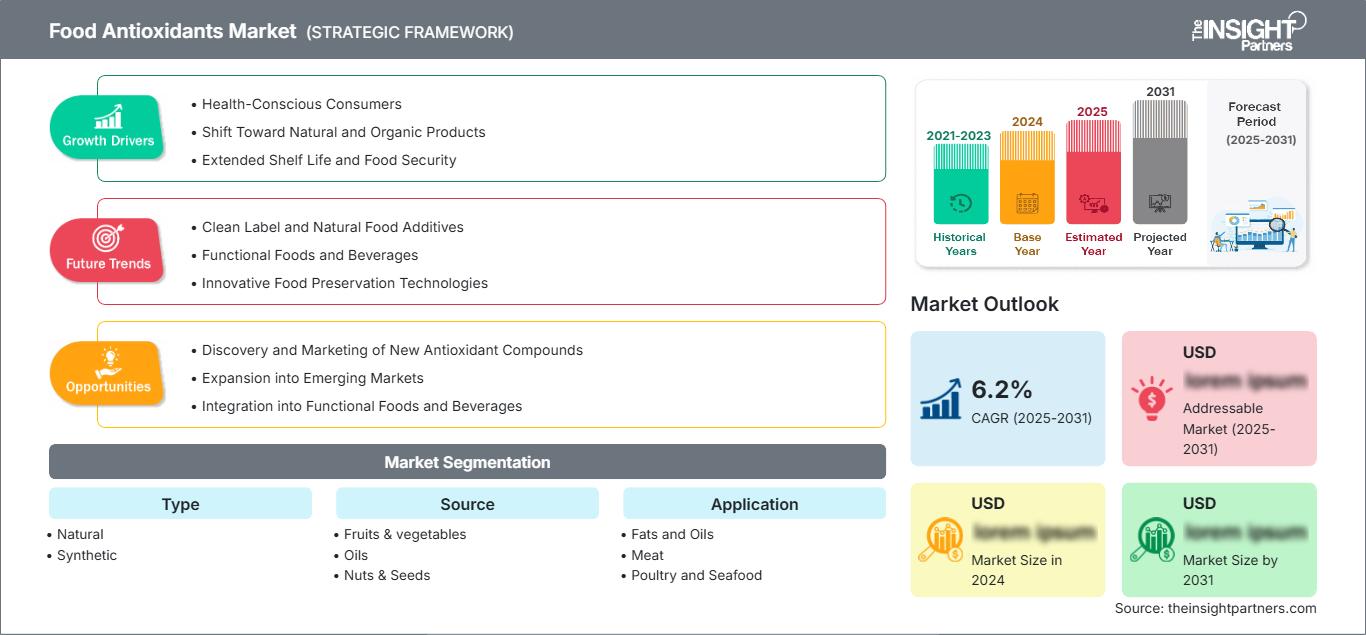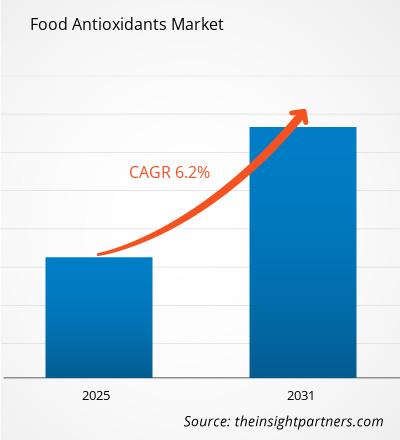Der Markt für Lebensmittel-Antioxidantien wird bis 2031 voraussichtlich ein Volumen von 2,23 Milliarden US-Dollar erreichen. Für den Zeitraum 2025–2031 wird ein jährliches Wachstum von 6,2 % erwartet.
Der Bericht zum Markt für Lebensmittel-Antioxidantien ist nach Typ in natürliche und synthetische Antioxidantien unterteilt. Zu den Quellen gehören Obst und Gemüse, Öle, Nüsse und Samen sowie Gewürze und Kräuter. Die Anwendungsbereiche umfassen Fette und Öle, Fleisch, Geflügel und Meeresfrüchte, Backwaren und Süßwaren sowie Getränke. Die Marktbewertung für die oben genannte Segmentanalyse wird in US-Dollar dargestellt. Die globale Analyse ist nach Regionen und wichtigen Ländern aufgeschlüsselt. Die Marktbewertung für die oben genannte Segmentanalyse wird in US-Dollar dargestellt.
Zweck des Berichts
Der Bericht „Markt für Lebensmittel-Antioxidantien“ von The Insight Partners beschreibt die aktuelle Marktlage und das zukünftige Wachstum sowie die wichtigsten Triebkräfte, Herausforderungen und Chancen. Dies wird verschiedenen Akteuren im Geschäftsbereich Einblicke ermöglichen, wie beispielsweise:
- Technologieanbieter/Hersteller: Um die sich entwickelnde Marktdynamik zu verstehen und potenzielle Wachstumschancen zu erkennen, können sie fundierte strategische Entscheidungen treffen.
- Investoren: Um eine umfassende Trendanalyse hinsichtlich Marktwachstumsrate, Finanzprognosen und Chancen entlang der Wertschöpfungskette durchzuführen.
- Regulierungsbehörden: Um Richtlinien zu regulieren und Aktivitäten auf dem Markt zu überwachen, mit dem Ziel, Missbrauch zu minimieren, das Vertrauen der Anleger zu wahren und die Integrität und Stabilität des Marktes zu gewährleisten.
Marktsegmentierung für Lebensmittel-Antioxidantien Typ
- Natürlich
- Synthetisch
Quelle
- Obst & Gemüse
- Öle
- Nüsse & Samen
- Gewürze & Kräuter
Anwendung
- Fette und Öle
- Fleisch
- Geflügel und Meeresfrüchte
- Backwaren und Süßwaren
- Getränke
Geografie
- Nordamerika
- Europa
- Asien-Pazifik
- Süd- und Mittelamerika
- Naher Osten und Afrika
Sie erhalten kostenlos Anpassungen an jedem Bericht, einschließlich Teilen dieses Berichts oder einer Analyse auf Länderebene, eines Excel-Datenpakets sowie tolle Angebote und Rabatte für Start-ups und Universitäten.
Markt für Lebensmittelantioxidantien: Strategische Einblicke

-
Holen Sie sich die wichtigsten Markttrends aus diesem Bericht.Dieses KOSTENLOSE Beispiel umfasst Datenanalysen, die von Markttrends bis hin zu Schätzungen und Prognosen reichen.
Wachstumstreiber für den Markt für Lebensmittel-Antioxidantien
- Gesundheitsbewusste Verbraucher: Das wachsende Bewusstsein für die gesundheitlichen Vorteile von Antioxidantien, insbesondere ihre Rolle bei der Reduzierung von oxidativem Stress und der Prävention chronischer Krankheiten, veranlasst Verbraucher, nach gesünderen, antioxidantienreichen Lebensmitteln zu suchen.
- Hinwendung zu natürlichen und biologischen Produkten: Die steigende Nachfrage nach natürlichen und biologischen Lebensmitteln, bedingt durch Bedenken hinsichtlich der Nebenwirkungen synthetischer Zusatzstoffe, treibt das Wachstum des Marktes für Lebensmittel-Antioxidantien an, insbesondere solcher, die aus pflanzlichen und natürlichen Zutaten gewonnen werden.
- Verlängerte Haltbarkeit und Lebensmittelsicherheit: Antioxidantien werden zunehmend eingesetzt, um die Haltbarkeit von Lebensmitteln zu verlängern, indem sie Oxidation, eine Hauptursache für Verderb, verhindern. Dies trägt zur Reduzierung von Lebensmittelabfällen und zur Verbesserung der Lebensmittelsicherheit bei und steigert die Nachfrage nach Antioxidantien in der Lebensmittelkonservierung. Wachstum bei verarbeiteten und verpackten Lebensmitteln: Mit dem anhaltenden Wachstum der Lebensmittel- und Getränkeindustrie, insbesondere in Schwellenländern, steigt auch der Bedarf an Antioxidantien als essenzielle Lebensmittelzusatzstoffe zur Erhaltung der Produktqualität und Verlängerung der Haltbarkeit. Zukunftstrends des Marktes für Lebensmittel-Antioxidantien: Die wachsende Verbraucherpräferenz für einfache, erkennbare Zutaten treibt die Nachfrage nach natürlichen, pflanzlichen Antioxidantien an. Dieser Trend veranlasst Hersteller, sich auf Clean-Label-Produkte ohne künstliche Zusatzstoffe oder Konservierungsmittel zu konzentrieren. Funktionelle Lebensmittel und Getränke: Die steigende Beliebtheit funktioneller Lebensmittel und Getränke, die über die Grundversorgung mit Nährstoffen hinaus gesundheitliche Vorteile bieten, erhöht die Nachfrage nach Antioxidantien. Diese Produkte werden mit bioaktiven Verbindungen, darunter Antioxidantien, angereichert, um die allgemeine Gesundheit und das Wohlbefinden zu verbessern. Innovative Technologien zur Lebensmittelkonservierung: Die Entwicklung von Verpackungen und Beschichtungen auf Basis von Antioxidantien revolutioniert die Lebensmittelkonservierung. Diese Technologien tragen dazu bei, die Haltbarkeit von Lebensmitteln zu verlängern und Lebensmittelabfälle zu reduzieren, wodurch die Nachfrage nach Antioxidantien in Verpackungslösungen steigt.
- Personalisierte Ernährung: Da Verbraucher sich ihrer spezifischen Ernährungsbedürfnisse immer bewusster werden, steigt die Nachfrage nach individualisierten Lebensmitteln. Maßgeschneiderte Antioxidantien in diesen Produkten helfen, auf individuelle Gesundheitsbedürfnisse einzugehen und fördern Innovation und Wachstum auf dem Markt für Lebensmittel-Antioxidantien.
Marktchancen für Lebensmittel-Antioxidantien
- Entdeckung und Vermarktung neuer antioxidativer Verbindungen: Die Entwicklung neuartiger antioxidativer Moleküle aus einzigartigen natürlichen Quellen bietet Unternehmen eine große Chance, sich im Markt zu differenzieren. Durch das Angebot innovativer antioxidativer Verbindungen können Unternehmen ein überzeugendes Wertversprechen schaffen und die Verbrauchernachfrage nach neuen, wirksamen Antioxidantien befriedigen.
- Expansion in Schwellenländer: Mit dem wachsenden Gesundheits- und Wellnessbewusstsein in Schwellenländern steigt die Nachfrage nach antioxidantienreichen Lebensmitteln. Unternehmen können diese neuen Märkte erschließen, um ihren Kundenstamm zu erweitern und das Marktwachstum anzukurbeln, indem sie vom zunehmenden Fokus auf Ernährung und Wellness in diesen Regionen profitieren. Integration in funktionelle Lebensmittel und Getränke: Die Nachfrage nach funktionellen Lebensmitteln und Getränken steigt, und Antioxidantien können mit anderen funktionellen Inhaltsstoffen wie Probiotika oder Omega-3-Fettsäuren kombiniert werden, um vielfältige gesundheitliche Vorteile zu bieten. Diese Integration schafft Möglichkeiten für Produktinnovationen und eine gesteigerte Attraktivität für die Verbraucher. Nachhaltigkeit und ökologische Produktion: Die Anwendung nachhaltiger und umweltfreundlicher Produktionsverfahren für Antioxidantien kann einen Wettbewerbsvorteil bieten, da umweltbewusste Verbraucher Produkte bevorzugen, die mit minimalen Umweltauswirkungen hergestellt werden. Die Reduzierung des CO₂-Fußabdrucks durch nachhaltige Praktiken kann die Markenreputation stärken und einen größeren Kundenstamm gewinnen.
Markt für Lebensmittel-Antioxidantien
Die regionalen Trends und Einflussfaktoren auf den Markt für Lebensmittel-Antioxidantien im gesamten Prognosezeitraum wurden von den Analysten von The Insight Partners ausführlich erläutert. Dieser Abschnitt behandelt außerdem die Marktsegmente und die geografische Verteilung des Marktes für das Management von Herzrhythmusstörungen in Nordamerika, Europa, Asien-Pazifik, dem Nahen Osten und Afrika sowie Süd- und Mittelamerika.
Umfang des Marktberichts zu Lebensmittel-Antioxidantien
By Quelle- Obst und Gemüse
- Öle
- Nüsse und Samen
- Gewürze und Kräuter
- Fette und Öle
- Fleisch
- Geflügel und Meeresfrüchte
- Back- und Süßwaren
- Getränke
- Nordamerika
- Europa
- Asien-Pazifik
- Süd- und Mittelamerika
- Naher Osten und Afrika
- Großbritannien
- Deutschland
- Frankreich
- Russland
- Italien
- Restliches Europa
- China
- Indien
- Japan
- Australien
- Restlicher Asien-Pazifik
- Brasilien
- Argentinien
- Restliches Süd- und Mittelamerika
- Südafrika
- Saudi-Arabien
- Vereinigte Arabische Emirate
- Restlicher Naher Osten und Afrika
Berichtsattribut Einzelheiten Marktgröße in 2024 US$ XX Billion Marktgröße nach 2031 US$ 2.23 Billion Globale CAGR (2025 - 2031) 6.2% Historische Daten 2021-2023 Prognosezeitraum 2025-2031 Abgedeckte Segmente By Typ - natürlich
- synthetisch
Abgedeckte Regionen und Länder Nordamerika - USA
- Kanada
- Mexiko
Marktführer und wichtige Unternehmensprofile - Archer Daniels Midland Company
- Barentz
- BASF SE
- Camlin Fine Sciences Ltd
- E.I. Du Pont De Nemours and Company
- Eastman Chemical Company
- Frutarom Group
- Kalsec Inc.
- Kemin Industries, Inc.
Dichte der Akteure auf dem Markt für Lebensmittel-Antioxidantien: Auswirkungen auf die Geschäftsdynamik
Der Markt für Lebensmittel-Antioxidantien wächst rasant, angetrieben durch die steigende Nachfrage der Endverbraucher. Gründe hierfür sind unter anderem sich wandelnde Verbraucherpräferenzen, technologische Fortschritte und ein wachsendes Bewusstsein für die Vorteile des Produkts. Mit steigender Nachfrage erweitern Unternehmen ihr Angebot, entwickeln innovative Produkte, um den Bedürfnissen der Verbraucher gerecht zu werden, und nutzen neue Trends, was das Marktwachstum weiter ankurbelt.

- Holen Sie sich die Markt für Lebensmittelantioxidantien Übersicht der wichtigsten Akteure
Wichtigste Verkaufsargumente
- Umfassende Abdeckung: Der Bericht bietet eine umfassende Analyse der Produkte, Dienstleistungen, Typen und Endverbraucher des Marktes für Lebensmittel-Antioxidantien und vermittelt so ein ganzheitliches Bild.
- Expertenanalyse: Der Bericht basiert auf dem fundierten Wissen von Branchenexperten und Analysten.
- Aktuelle Informationen: Der Bericht gewährleistet Geschäftsrelevanz durch die Berücksichtigung aktueller Informationen und Datentrends.
- Anpassungsmöglichkeiten: Dieser Bericht kann an spezifische Kundenanforderungen angepasst werden und sich optimal in die Geschäftsstrategien integrieren.
Der Forschungsbericht zum Markt für Lebensmittel-Antioxidantien kann somit maßgeblich dazu beitragen, das Branchenszenario und die Wachstumsaussichten zu entschlüsseln und zu verstehen. Auch wenn einige berechtigte Bedenken bestehen, überwiegen die Vorteile dieses Berichts insgesamt die Nachteile.
- Historische Analyse (2 Jahre), Basisjahr, Prognose (7 Jahre) mit CAGR
- PEST- und SWOT-Analyse
- Marktgröße Wert/Volumen – Global, Regional, Land
- Branchen- und Wettbewerbslandschaft
- Excel-Datensatz
Aktuelle Berichte
Verwandte Berichte
Erfahrungsberichte
Grund zum Kauf
- Fundierte Entscheidungsfindung
- Marktdynamik verstehen
- Wettbewerbsanalyse
- Kundeneinblicke
- Marktprognosen
- Risikominimierung
- Strategische Planung
- Investitionsbegründung
- Identifizierung neuer Märkte
- Verbesserung von Marketingstrategien
- Steigerung der Betriebseffizienz
- Anpassung an regulatorische Trends






















 Kostenlose Probe anfordern für - Markt für Lebensmittelantioxidantien
Kostenlose Probe anfordern für - Markt für Lebensmittelantioxidantien